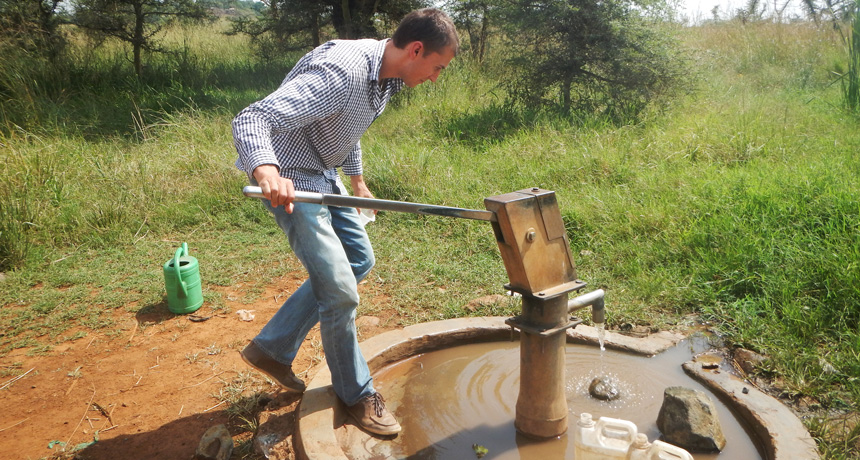‘Fossil’ groundwater is not immune to modern-day pollution
Deep well study finds contamination in at least 12,000-year-old water

DEEP WATER Deep groundwater wells, such as this hand-pumped well in Uganda being operated by water resources scientist Scott Jasechko, can contain mixes of old and young water and traces of pollution.
Merhawi GebreEgziabher
Groundwater that has lingered in Earth’s depths for more than 12,000 years is surprisingly vulnerable to modern pollution from human activities. Once in place, that pollution could stick around for thousands of years, researchers report online April 25 in Nature Geoscience. Scientists previously assumed such deep waters were largely immune to contamination from the surface.
“We can’t just drill deep and expect to run away from contaminants on the land surface,” says Scott Jasechko, a study coauthor and water resources scientist at the University of Calgary in Canada.
Groundwater quenches the thirst of billions of people worldwide and accounts for roughly 40 percent of the water used in agriculture. Water percolating from the surface into underground aquifers can carry pollutants such as pesticides and salt along for the ride.
Jasechko and colleagues weren’t looking for contamination when they tested water from 6,455 water wells around the world. Their goal was to use carbon dating to identify how much of that deep water was “fossil” groundwater formed more than 12,000 years ago. Previous studies had looked at average water age, rather than the age of its individual components.
While there’s no C in H2O, carbon dating can still be used to date groundwater by examining the carbon dissolved in the water. Radioactive carbon atoms decay as the water ages. After around 12,000 years, only stable carbon isotopes remain. Comparing the relative abundance of these carbon isotopes in the various wells, the researchers discovered that over half of wells more than 250 meters deep yielded mostly groundwater at least 12,000 years old. How much older is unknown. Worldwide, the researchers estimate that fossil groundwater accounts for 42 to 85 percent of water in the top kilometer of Earth’s crust.
In a second measurement, the researchers looked for a common modern pollutant. They found that around half of wells containing mostly fossil groundwater had elevated traces of tritium, a radioactive hydrogen isotope spread during nuclear bomb tests that’s hazardous in very high concentrations. While the tritium levels weren’t dangerous, its presence suggests that at least some groundwater in the wells postdates the 1950s nuclear testing. That relatively young water may introduce other contaminants in addition to tritium, the researchers say.
How new groundwater enters deep wells is still unclear, Jasechko says. Old and young waters could mix within an aquifer or, alternatively, the construction and use of the well itself could churn the waters together.
No matter where the young water comes from, the new technique for identifying the percentage of fossil groundwater in a well could be an important tool for communities, says Audrey Sawyer, a hydrogeologist at Ohio State University in Columbus. The study raises awareness that even in wells with mostly older water “a fraction of that same water can be pretty young and susceptible to contamination,” she says.








